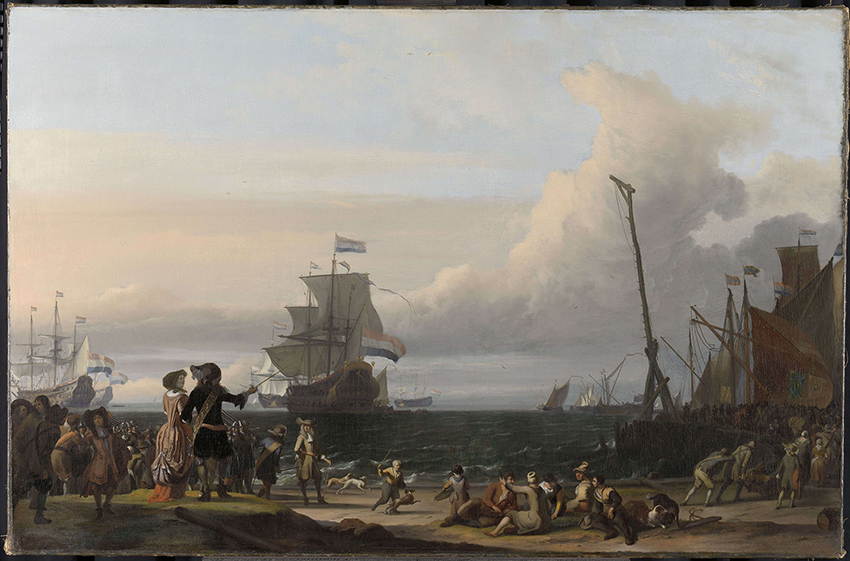The Roads of Texel


The Roads of Texel was an essential logistic hub for Dutch shipping for centuries. A roads, or roadstead, is a more or less sheltered place where ships anchor, often in a bay or in the lee of a coastline. The east coast of Texel had served as a roadstead since the 15th century, after the Hors bay at the south end of the island had become increasingly shallow.
Texel Roads
These new Texel Roads stretched along the coastline of the whole island. It was a gathering point for ships wishing to sail onwards to the North Sea from coastal locations on the Zuiderzee, or the other way round. The Zuiderzee has always been relatively shallow sailing water. As ships became larger and heavier it became increasingly difficult to sail them over the Zuiderzee. This meant that the Texel Roads developed into the location in which large ships loaded and unloaded their cargos. After that, small barges (lighters) were used to transport the trading goods to their final destination. At the end of the sixteenth century, trade was increasing and this also became apparent on Texel. The number of ships using the Roads grew significantly. The Texel Roads became an important logistic hub for overseas trade.
Hustle and bustle
Historical sources show that there were sometimes dozens or even more than a hundred ships at a time anchored on the Roads. They were waiting to load cargo or provisions and for favourable winds by which to set sail. Ships may have anchored for weeks, sometimes even months, on the Roads.
Most of the ships were active in European coastal shipping. An extensive trade network stretched from the Baltic Sea and Russia to the Levant and Syria. In addition, fleets of the Dutch East India Company (VOC) and the Dutch West India Company (WIC) were to be found on the Roads, as were warships of the Dutch Admiralty. Smaller vessels travelled back and forth between the fleets: fishing boats, sloops carrying crew, pilot boats and barges known as lighters. All this activity would have created a busy scene, with hundreds of people involved at a time. For the inhabitants of Texel this was a period of great employment opportunities and prosperity.
 Special water
Special water
The island itself played a crucial role in supplying the ships on the Roads with provisions. Two water wells at the foot of the Hoge Berg on Texel became famous as they were capable of supplying large quantities of high-quality water. These wells were known as the Wezenputten, as the proceeds of the water benefitted the orphanage in Den Burg. The water from the wells was very rich in iron, meaning that the water remained drinkable for a few months longer than ‘normal’ drinking water.
No safe haven
The Texel Roads provided a good degree of protection but was not really a safe haven. Extremely heavy storms could endanger the lives of the seafarers on the Roads. Various disastrous shipping catastrophes are known of in which dozens of ships were lost and hundreds of victims mourned. In severe storms, ships could break loose of their anchor, with the danger of crashing into each other or stranding on a sandbank. Ships could then sink relatively quickly. To prevent this happening, extra anchors were thrown out or anchor ropes weighted down with the barrel of a cannon. Whole masts were even cut down as a last resort: anything to prevent dislodging of the anchors and the ship stranding. It is estimated that between 500 and 1000 ships sunk on and around the Texel Roads throughout the centuries. Most were lost completely. Since the 1970’s, about forty of these ships have been found again, in varying degrees of completeness. Due to corrosion, most of these have since perished.
The demise of the Roads
Trade and shipping virtually came to a standstill in the second half of the eighteenth century, also on Texel. The Dutch economy was paralyzed by a series of wars which were partly fought at sea and also by the civil war between patriots and orangists. Boosting trade, and with it the Roads, was unsuccessful during the subsequent French period. The opening of the Great North Holland Canal (1824) meant that ships no longer had to sail over the tricky Zuiderzee: they could now travel straight from Amsterdam to Den Helder. The era of the Texel Roads was over.

 Special water
Special water
